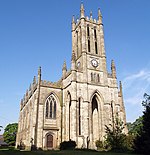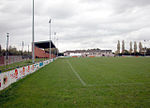Whitefield tram stop
Former Lancashire and Yorkshire Railway stationsRailway stations in Great Britain closed in 1991Railway stations in Great Britain opened in 1879Railway stations in Great Britain opened in 1992Tram stops in the Metropolitan Borough of Bury ... and 5 more
Tram stops on the Altrincham to Bury lineTram stops on the Bury to Ashton-under-Lyne lineUse British English from January 2021Vague or ambiguous time from February 2013Whitefield, Greater Manchester

Whitefield is a tram stop in the town of Whitefield, Greater Manchester, England. It is on the Bury Line of Greater Manchester's light rail Metrolink system.
Excerpt from the Wikipedia article Whitefield tram stop (License: CC BY-SA 3.0, Authors, Images).Whitefield tram stop
Stanley Road,
Geographical coordinates (GPS) Address Nearby Places Show on map
Geographical coordinates (GPS)
| Latitude | Longitude |
|---|---|
| N 53.55117 ° | E -2.2951 ° |
Address
Whitefield
Stanley Road
M45 8GT , Besses o' th' Barn
England, United Kingdom
Open on Google Maps







